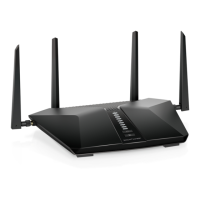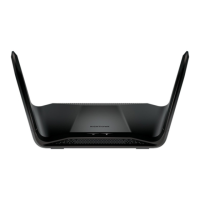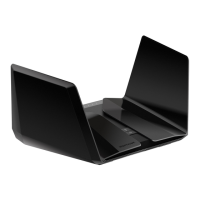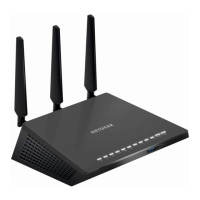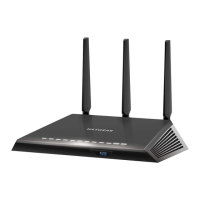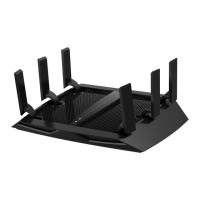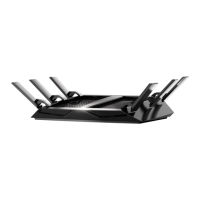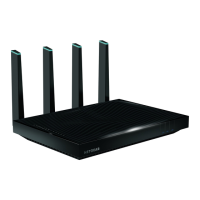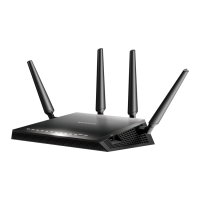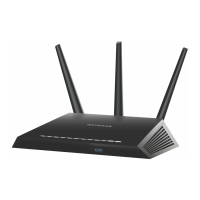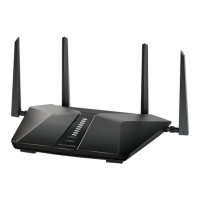
Do you have a question about the NETGEAR Nighthawk AX6 AX4300 and is the answer not in the manual?
| Brand | NETGEAR |
|---|---|
| Model | Nighthawk AX6 AX4300 |
| Category | Wireless Router |
| Language | English |
Details on router package contents and initial unboxing.
Explains status LEDs and buttons on the router's top panel.
Describes connectors and buttons found on the router's rear panel.
Information on the label containing login details, SSID, and MAC address.
Instructions for attaching and positioning the router's antennas correctly.
Guidelines for optimal router placement to maximize WiFi range and performance.
Steps to securely mount the router on a wall using provided holes.
Instructions for connecting the router to the modem and power supply.
Methods for connecting devices via wired Ethernet or WiFi.
Explains different login credentials for ISP, WiFi, NETGEAR account, and router.
Guides on accessing router settings via a web browser interface.
Instructions for using the mobile app for router installation and management.
Steps to change the language of the router's web interface.
Wizard to automatically detect and configure Internet settings for the router.
Detailed steps for manually configuring various Internet connection types.
Configuration options for setting up IPv6 connectivity if not auto-detected.
Explains MTU concepts and how to adjust the size for optimal performance.
Configure rules to permit or deny internet access for specific devices.
Methods to block specific websites using keywords or domain names.
Manage Access Control Lists (ACLs) to control network access for devices.
Set schedules to block specific websites and services during certain times.
Configure the router to send email alerts for security events and logs.
Configure Wide Area Network (WAN) settings, including security and MTU.
Configure a DMZ server to expose specific devices to the internet for gaming/apps.
Customize the name displayed for the router on the network.
Modify Local Area Network (LAN) IP address, subnet mask, and RIP settings.
Assign static IP addresses to devices for consistent network access.
Configure fundamental WiFi settings like SSID, region, and broadcast.
Update the WiFi network name (SSID) and security settings.
Create a separate WiFi network for guests with different security settings.
Configure the router to function as a WiFi access point in an existing network.
Configure bridging for specific ports or VLAN tags, often for IPTV.
Define static routes for specific network traffic paths.
Configure the router to act as a bridge to extend network connectivity.
Configure Dynamic Quality of Service to prioritize traffic and manage bandwidth.
Enable UPnP for easier device discovery and network resource access.
Understand WMM QoS for prioritizing WiFi voice and video traffic.
Control AX WiFi settings to leverage advanced WiFi features.
Check for and install the latest router firmware for security and features.
Securely change the router's administrator login password.
Set up security questions to recover a forgotten admin password.
Steps to recover the router's admin password using security questions.
Access detailed status and configuration information for the router and network.
Monitor the router's current Internet connection status and details.
Track and set limits for Internet traffic volume and connection time.
Back up, restore, or erase router configuration settings.
Set up and use remote management to access the router over the Internet.
Reset the router to its original factory default configuration.
Details on compatible USB storage devices and file system support.
Steps for physically connecting a USB storage device to the router.
How to access shared USB storage from a Windows PC.
Steps to map a USB storage device as a network drive in Windows.
Instructions for accessing shared USB storage from a Mac computer.
Configure FTP access for faster file transfers over the network.
Create and configure network folders on connected USB storage.
Procedure to safely disconnect a USB storage device from the router.
Configure Dynamic DNS to access the network using a domain name.
Enable FTP access for remote file sharing via the Internet.
Steps to set up a personal FTP server using Dynamic DNS.
How to access USB storage remotely via the Internet using DDNS or IP address.
Establish a secure VPN client-to-gateway tunnel for remote access.
Configure VPN service type, port, and other settings on the router.
Guides for installing OpenVPN client software on various devices.
Establish a VPN tunnel from a Windows computer to the router.
Access router USB devices and media remotely via VPN.
Use VPN to access your home Internet service while away.
Configure rules to forward incoming Internet traffic to specific local servers.
Set up dynamic port opening based on outbound traffic for specific applications.
General troubleshooting advice and network restart sequence.
Diagnose issues by interpreting the status of the router's LEDs.
Steps to resolve issues preventing access to the router's web interface.
Troubleshoot problems preventing the router from connecting to the Internet.
Resolve issues with loading web pages, DNS, and gateway configuration.
Solutions for when router configuration changes are not applied or saved.
Diagnose and fix problems with connecting to the router's WiFi network.
Use the ping utility to test network paths and diagnose connectivity issues.
Details default router settings and how to reset to factory defaults.
Lists hardware specifications, protocols, power, and environmental details.
